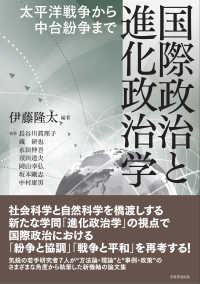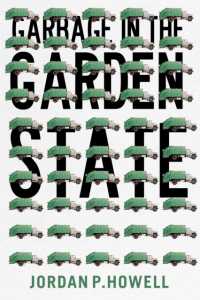Full Description
The Routledge Companion to New Cinema History presents the most recent approaches and methods in the study of the social experience of cinema, from its origins in vaudeville and traveling exhibitions to the multiplexes of today.
Exploring its history from the perspective of the cinemagoer, the study of new cinema history examines the circulation and consumption of cinema, the political and legal structures that underpinned its activities, the place that it occupied in the lives of its audiences and the traces that it left in their memories. Using a broad range of methods from the statistical analyses of box office economics to ethnography, oral history, and memory studies, this approach has brought about an undisputable change in how we study cinema, and the questions we ask about its history. This companion examines the place, space, and practices of film exhibition and programming; the questions of gender and ethnicity within the cinematic experience; and the ways in which audiences gave meaning to cinemagoing practices, specific films, stars, and venues, and its operation as a site of social and cultural exchange from Detroit and Laredo to Bandung and Chennai. Contributors demonstrate how the digitization of source materials and the use of digital research tools have enabled them to map previously unexplored aspects of cinema's business and social history and undertake comparative analysis of the diversity of the social experience of cinema across regional, national, and continental boundaries.
With contributions from leading scholars in the field, The Routledge Companion to New Cinema History enlarges and refines our understanding of cinema's place in the social history of the twentieth century.
Contents
Introduction: The scope of new cinema history, Daniel Biltereyst, Richard Maltby and Philippe Meers
PART 1. Reflections and comments
Introduction: the scope of new cinema history, Daniel Biltereyst, Richard Maltby, and Philippe Meers
PART I. Reflections and comments
Introduction
1. Connections, intermediality, and the anti-archive: a conversation with Robert C. Allen, Richard Maltby and Philippe Meers
2. Film history, cultural memory, and the experience of cinema: a conversation with Annette Kuhn, Daniel Biltereyst
3. How I became a new cinema historian, Melvyn Stokes
4. The subject of history and the clutter of phenomena, John Caughie
5. The new nontheatrical cinema history?, Gregory A. Waller
PART II. Challenges and opportunities
Introduction
6. Reading newspapers and writing American silent cinema history, Richard Abel
7. Arclights and zoom lenses: searching for influential exhibitors in film history's big data, Eric Hoyt
8. Comparing historical cinema cultures: reflections on new cinema history and comparison with a cross-national case study on Antwerp and Rotterdam, Daniel Biltereyst, Thunnis van Oort and Philippe Meers
9. The archaeology of itinerant film exhibition: unpacking the Brinton Entertainment Company Collection, Kathryn Fuller-Seeley
10. Cinema history as social history: retrospect and prospect, Judith Thissen
PART III. Distribution and trade
Introduction
11. Early film stars in trade journals and newspapers: data-based research on global distribution and local exhibition, Martin Loiperdinger
12. The high stakes conflict between the Motion Picture Export Association and the Netherlands Cinema Association 1945-1946, Clara Pafort-Overduin and Douglas Gomery
13. "Perhaps everyone has forgotten just how pictures are shown to the public": continuous performance and double billing in the 1930s, Richard Maltby
14. "When in doubt, Showcase": The rise and fall of United Artists' revolutionary New York distribution pattern, Zoë Wallin
15. When distributors' trash becomes exhibitors' treasure: rethinking film success and failure, Dean Brandum, Bronwyn Coate, and Deb Verhoeven
PART IV. Exhibition, place and space
Introduction
16. Roll the credits: gender, geography, and the people's history of cinema, Jeffrey Klenotic
17. Three moments of cinema exhibition, Mike Walsh, Richard Maltby, and Dylan Walker
18. Currents of empire: transport, electricity, and early film exhibition in colonial Indonesia, Dafna Ruppin
19. Remembering the first movie theatres and early cinema exhibition in Quay, Smyrna, Turkey, Dilek Kaya
20. Exhibiting films in a predominantly Mexican American market: the case of Laredo, Texas, a small USA-Mexico border town, 1896-1960, José Carlos Lozano
PART V. Programming, popularity, and film
Introduction
21. Popular filmgoing in mid-1950s Milan: opening up the 'black box', John Sedgwick and Marina Nicoli
22. Distribution and exhibition in Warner Bros. Philadelphia Theaters, 1935-1936, Catherine Jurca
23. To be continued...: seriality, cyclicality and the new cinema history, Tim Snelson
24. Kino-barons and noble minds: specifics of film exhibition beyond commercial entertainment, Lucie Česálková
25. When the history of moviegoing is a history of movie watching, then what about the films?, Frank Kessler and Sabine Lenk
26. The evergreens and mayflies of film history: the age distribution of films in exhibition, Karel Dibbets
PART VI. Audiences, reception, and cinemagoing experiences
Introduction
27. Analysing memories through video-interviews: a case study of post-war Italian cinemagoing, Daniela Treveri Gennari, Silvia Dibeltulo, Danielle Hipkins, and Catherine O'Rawe
28. Social sense and embodied sensibility: towards a historical phenomenology of filmgoing, Stephen Putnam Hughes
29. "It Pays to Plan 'em!": the newspaper movie directory and the paternal logic of mass onsumption, Paul S. Moore
30. Why young people still go to the movies: historical and contemporary cinemagoing audiences in Belgium, Liesbet Van de Vijver
31. For many but not for all: Italian film history and the circumstantial value of audience studies, Mariagrazia Fanchi






